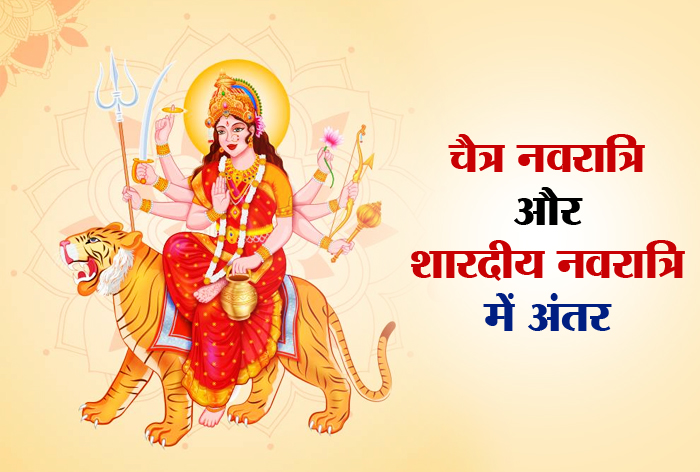Navratri, or "nine nights," is one of the most important Hindu festivals in honor of Goddess Durga and her nine divine incarnations. Celebrated twice annually, the two major Navratris are Chaitra Navratri and Shardiya Navratri. Although both festivals have the same spirit of devotion and worship of the divine feminine power, they vary in terms of timing, importance, rituals, and cultural traditions. Let us learn about these differences in detail.
Introduction to Chaitra Navratri and Shardiya Navratri
Chaitra Navratri falls in the Hindu month of Chaitra (March-April), which is the beginning of spring and the start of the Hindu New Year in most parts of India. Shardiya Navratri, on the contrary, is celebrated in the month of Ashwin (September-October) during autumn and ends with Dussehra or Vijayadashami, which represents the victory of good over evil. Both the festivals are in honor of Goddess Durga, but their seasonal background and related customs distinguish them from each other.
Timing and Seasonal Significance
-
Chaitra Navratri: Celebrated in March-April, Chaitra Navratri coincides with the spring season. This is a time of renewal, growth, and new beginnings. It is also the beginning of the Hindu lunar calendar, so it is a time of spiritual introspection.
-
Shardiya Navratri: They are observed in September-October, the time when autumn is experienced. Autumn symbolizes harvest and abundance, so it is the season to give thanks and rejoice. The festival culminates in Dussehra, which is the celebration of Lord Rama's victory over Ravana and that of Goddess Durga over Mahishasura.
Mythological and Religious Significance
The mythological stories revolving around these Navratris emphasize their special significance:
Chaitra Navratri: This festival is closely associated with Lord Rama. It is believed that Lord Rama worshipped Goddess Durga before the battle with Ravana. The ninth day of Chaitra Navratri is also known as Ram Navami, which is the birthday anniversary of Lord Rama. There is also a belief that the universe was created by Lord Brahma at this time.
Shardiya Navratri: Shardiya Navratri has its origins in the myth of Goddess Durga slaying Mahishasura following nine nights of intense combat. The tenth day, Vijayadashami or Dussehra, commemorates that victory as the victory of good over evil. Moreover, the victory of Lord Rama over Ravana is also reenacted in the form of Ram Leela performances during these days.
Rituals and Customs
Both the festivals include fasting, prayers, and worship of the nine forms of Goddess Durga over nine days. But their rituals have regional differences:
Chaitra Navratri:
-
Starts with Ghatasthapana (Kalash Sthapana), marking Goddess Durga's arrival.
-
People perform daily pujas of different avatars of Durga like Shailputri, Brahmacharini, Chandraghanta, etc., wearing distinct colors corresponding to each day.
-
The festival ends with Ram Navami celebrations comprising bhajans, processions, and pujas dedicated to Lord Rama.
-
In states like Maharashtra and Andhra Pradesh, it overlaps with Gudi Padwa or Ugadi, local New Year celebrations.
Shardiya Navratri:
-
Beings with Ghatasthapana, the sowing of barley seeds in a holy vessel to represent development and prosperity.
-
Comprises rich cultural festivities like Garba and Dandiya Raas dance in Gujarat or Durga Puja celebrations in Bengal.
-
Closes with Vijayadashami with great processions and immolation of Ravana effigies to mark the victory of good over evil.
-
Houses are lit up with lights, flowers, and rangoli designs to greet the festive mood.
Cultural Differences
The cultural significance is different in different places:
Chaitra Navratri: Dominant in northern India and Maharashtra. It is celebrated simply as opposed to Shardiya Navratri but carries great spiritual weightage because of its connection with Ram Navami and Hindu New Year.
Shardiya Navratri: Richly celebrated in Gujarat (Garba dances), West Bengal (Durga Puja), and northern India (Ram Leela performances). More vibrant because of its culmination on Dussehra celebrations drawing mass-level public involvement.
Spiritual Focus
Though both these festivals focus on devotion to Goddess Durga:
Chaitra Navratri promotes mental resilience and spiritual evolution through meditation and fasting practices. It is held to be perfect for satisfying spiritual longings.
Shardiya Navratri emphasizes worldly festivities along with religious devotion. It is regarded as a period for the attainment of material desires along with gratitude for prosperity.
Conclusion
Chaitra Navratri and Shardiya Navratri are two separate but equally important festivals that celebrate Goddess Durga's divine energy. While Chaitra Navratri brings spring with motifs of rebirth and spiritual revival, Shardiya Navratri welcomes autumn's fertility in conjunction with cultural effervescence. Collectively, the two festivals depict India's vibrant fabric of traditions based on cyclical changes, mythology, and piety.
Whether solemnly marked or celebrated with much pomp, both Chaitra and Shardiya Navratris recall the ageless circle of life—renewal in the wake of hardship—and encourage us to draw strength from spiritual feminine power.
Source: Indian Community, Money Control, Times Now, NDTV, Omega Astro, Theartarium, Times Of India

